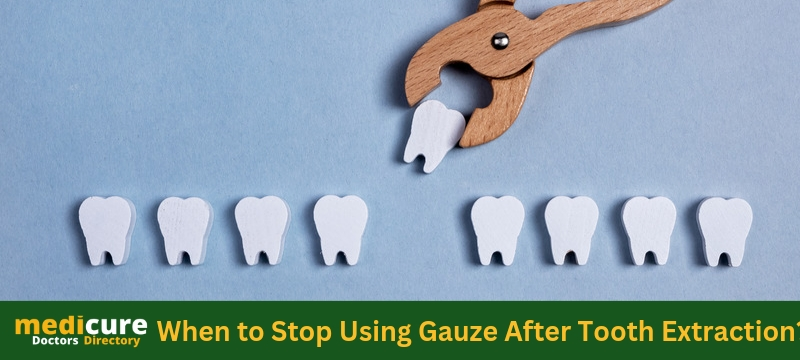MediCure

When to Stop Using Gauze After Tooth Extraction: A Comprehensive Guide
- February 16, 2024
- 0 Likes
- 0 Comments
Effective post-operative care plays a pivotal role in ensuring a smooth recovery following a tooth extraction procedure. When to Stop Using Gauze After Tooth Extraction Knowing when to stop using gauze is a crucial aspect of this care, as it promotes proper clot formation and reduces the risk of complications such as dry socket. By following the tips provided and consulting your dentist for personalized guidance, you can facilitate optimal healing and restore comfort to your oral health.
Thank you for reading this post, don't forget to subscribe!When to Stop Using Gauze After Tooth Extraction?
After undergoing a tooth extraction procedure, it’s crucial to follow proper post-operative care to ensure optimal healing. One common aspect of this care involves the use of gauze to control bleeding and promote clot formation. However, knowing when to stop using gauze is essential to prevent complications and promote healing.
When to Stop Using Gauze After Tooth Extraction?
In this guide, we’ll delve into the various factors that determine the appropriate duration for using gauze after a tooth extraction.
Understanding the Purpose of Gauze After Tooth Extraction:
Gauze plays a vital role in the immediate aftermath of a tooth extraction.
It helps to control bleeding by applying gentle pressure to the extraction site.
Additionally, gauze aids in the formation of a blood clot, which is crucial for proper healing.

Factors Influencing the Duration of Gauze Use:
1. Extent of the Extraction:
The complexity of the extraction procedure can impact how long gauze is needed.
2. Bleeding Severity:
Patients experiencing heavier bleeding may need to use gauze for a longer duration.
3. Individual Healing Response:
Healing varies from person to person, influencing the duration of gauze use.
When to Stop Using Gauze:
1. Monitor Bleeding:
Once bleeding has significantly decreased or stopped altogether, it may be time to discontinue gauze use.
2. Follow Dentist’s Instructions:
Dentists provide specific guidelines tailored to each patient’s needs, indicating when to cease using gauze.
3. Avoid Overuse:
Prolonged use of gauze can hinder clot formation and impede the healing process, so it’s essential not to use it longer than necessary.
Signs That It’s Time to Stop Using Gauze:
Minimal to No Bleeding:
When bleeding has subsided, and the extraction site appears relatively dry, gauze may no longer be required.
Stable Blood Clot:
A stable blood clot is essential for proper healing. Once a clot has formed adequately, gauze can be discontinued.
Comfortable Oral Sensation:
Patients often experience discomfort or sensitivity immediately after a tooth extraction. Once this subsides, it may indicate that gauze is no longer needed.
Tips for Effective Gauze Use:
1. Proper Placement:
Ensure that the gauze is placed directly over the extraction site, applying gentle but consistent pressure.
2. Bite Down Gently:
Bite down on the gauze to maintain pressure and facilitate clot formation. Avoid biting too hard to prevent discomfort or dislodging the clot.
3. Change Gauze Regularly:
Replace the gauze with a fresh piece every 30 minutes or as directed by your dentist. This helps maintain cleanliness and effectiveness.
4. Avoid Disturbing the Extraction Site:
Refrain from touching or poking the extraction site with your tongue or fingers, as this can disrupt clot formation and prolong bleeding.
5. Stay Hydrated:
Drink plenty of water to stay hydrated, but avoid using straws, as the sucking motion can dislodge the blood clot. Opt for sipping from a glass instead.
6. Rest and Relaxation:
Engage in light activities and avoid strenuous exercise or heavy lifting for the first 24 to 48 hours following the extraction. Resting allows the body to focus on healing.
7. Follow Post-Operative Instructions:
Your dentist will provide specific post-operative care instructions tailored to your needs. Adhere to these guidelines diligently for optimal recovery.
Importance of Timely Gauze Removal:
Prolonged use of gauze beyond the necessary duration can lead to complications such as dry socket, where the blood clot becomes dislodged or fails to form adequately.
Dry socket is characterized by severe pain, foul odor, and exposure of the underlying bone. It requires immediate attention from your dentist to alleviate symptoms and promote healing.
By recognizing the signs indicating when to stop using gauze, patients can minimize the risk of complications and expedite the healing process.
FAQs About When to Stop Using Gauze After Tooth Extraction?
Q: How often should I change the gauze?
A: Gauze should be changed approximately every 30 minutes or as instructed by your dentist.
Q: Can I sleep with gauze lin my mouth?
A: It’s generally recommended to remove gauze before sleeping to prevent choking hazards and allow for proper clot formation.
Q: What if bleeding persists even with gauze?
A: If bleeding continues despite using gauze, contact your dentist immediately for further guidance.
Conclusion of When to Stop Utilize Gauze After Tooth Extraction?
Knowing when to stop using gauze after a tooth extraction is crucial for promoting proper healing and preventing complications. By monitoring bleeding, following dentist’s instructions, and recognizing signs of clot formation, patients can ensure a smooth recovery process. Remember to consult your dentist for personalized guidance regarding post-extraction care.
Also: